Alberta's new carbon tax
Posted on 31 December 2015 by Andy Skuce
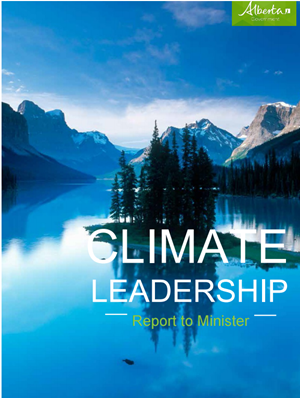 On Sunday November 22nd, 2015, Alberta's new centre-left Premier, Rachel Notley, announced that the province would be introducing an economy-wide carbon tax priced at $30 per tonne of CO2 equivalent, to be phased in in 2016 and 2017. Observers had been expecting new efforts to mitigate emissions since Notley's election in May 2015, but the scope and ambition of this policy took many by surprise.
On Sunday November 22nd, 2015, Alberta's new centre-left Premier, Rachel Notley, announced that the province would be introducing an economy-wide carbon tax priced at $30 per tonne of CO2 equivalent, to be phased in in 2016 and 2017. Observers had been expecting new efforts to mitigate emissions since Notley's election in May 2015, but the scope and ambition of this policy took many by surprise.
Alberta, of course, is the home of the Athabasca oil sands and is one of the largest per-capita GHG emitters of any jurisdiction in the world. The new plan was nevertheless endorsed by environmental groups, First Nations and by the biggest oil companies, an extraordinary consensus that many would not have thought possible.
How was this done? I will try and explain the new policy as far as I can (the details are not all available yet), but the short answer is that a huge amount of credit is due to the panel of experts led by University of Alberta energy economist Andrew Leach and his fellow panelists. Not only did they listen to what all Albertans had to say, but they were thoughtful in framing a policy that is acceptable to almost everyone.
The background
Alberta is the wealthiest province in Canada, with a population of 4.1 million. In 2013, greenhouse gas emissions were 267 Mt CO2 equivalent, about 65 tonnes per capita, which compares with the average for the rest of Canada of about 15 tonnes. Among US states only North Dakota and Wyoming are worse. Alberta's fugitive emissions of methane alone amount to 29 Mt CO2e, about 7 tonnes per person, which is a little more than the average for all GHGs per-capita emissions in the world.
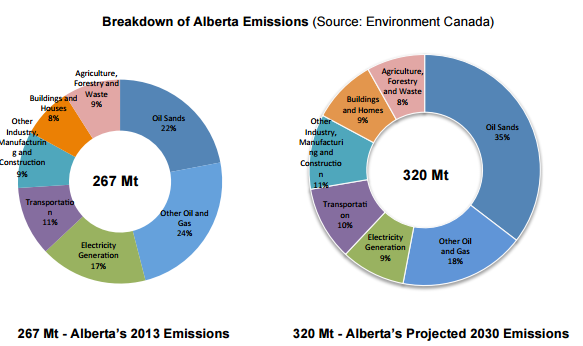
From the Climate Leadership Report. The 2030 emissions do not consider savings from the new policy.
Oil sands emissions and those from Alberta's other oil and gas industries make up nearly half of the province's emissions. But even if you remove those, Albertans emit an average of 35 tonnes each per year, much more than the average for countries like Canada, Australia or the United States. Alberta is a big place, with many wealthy people owning lots of large vehicles and living in large houses that have to be kept warm through long, cold winters. The province relies mostly on coal-fired electricity and on natural gas for home heating. Even apart from its petroleum industry, Alberta has a big emissions problem. Any mitigation policy obviously has to take aim at its petroleum industry, but the wider economy also needs to greatly reduce its use of fossil fuels.
Gratuitous picture of the Alberta Rockies to brighten up a dull post. Mount Lougheed (left, at the back), Wind Tower (left of centre) and my late, lamented dog Kim on the Wind Ridge Trail.
Outline of the policy elements
The policies and the rationale behind them are laid out in the document Climate Leadership Report. Writing in Maclean's Magazine, University of Calgary economist Trevor Tombe provided a useful guide to the details of the tax. I will just try to summarize Tombe's main points here. Many details await the implementation of the policy.
1) Economy-wide, $30/tonne and "revenue neutral"
The carbon tax will be applied economy-wide to all emitters at the rate of CAD$30/tonne of CO2e (USD$22) in 2017 with a phase-in year of CAD$20 per tonne in 2016. After 2017, the tax will rise at inflation plus 2%. CAD$30 is the amount levied in the neighbouring province of British Columbia.
This level of tax is within the lower part of the range of the social cost of carbon calculated by the US Environmental Protection Agency. Here's how the proposed tax looks out to 2050.
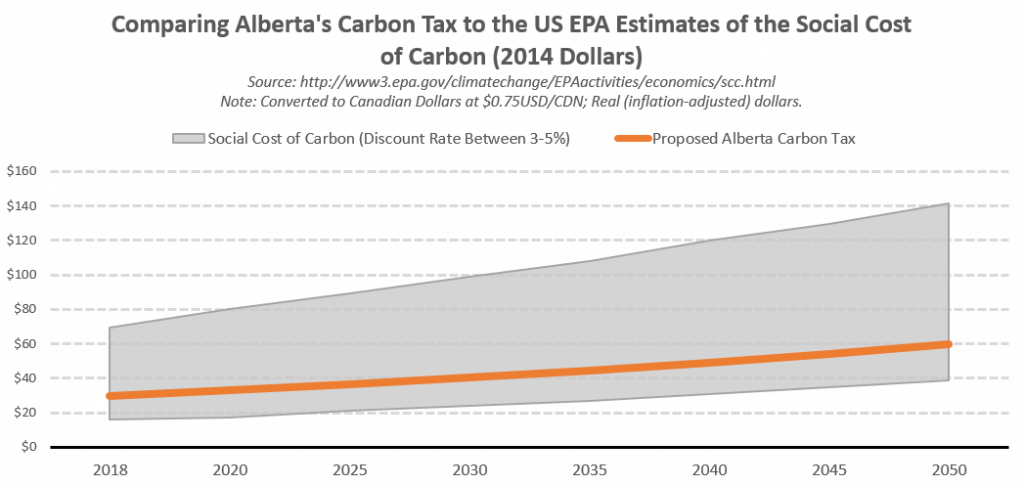
Graph by Trevor Tombe in Maclean's.
A tax at this level is large enough to influence behaviour, but it is too low, for example, to provide enough incentive to emitters to deploy carbon capture and storage (CCS). This would require a tax about three times as high.
Premier Notley described the tax as "revenue neutral", but it's not. All proceeds will not be paid back as reductions in other taxes (as BC does) but instead will be spent on rebates and targeted subsidies. David Roberts and Blair King claim that this is a positive aspect of the policy, rather than a defect. Nevertheless, others, for example The Citizens' Climate Lobby, argue for true revenue neutrality.
2) Rebates to families
Estimates of the annual impact of the tax on families range from CAD$300-600, for increased costs of electricity, natural gas (for home heating) and gasoline. The intent is to fully compensate the lowest-income 50% of families for these extra costs by paying them some fixed amount per family. At CAD$30 per tonne of CO2e, a carbon tax will raise the cost of gasoline by about 7 cents per litre (roughly 20 US cents per US gallon).
3) Subsidies to high emitters
What will probably strike many readers as the oddest feature is that some oil sands produces will, as a direct consequence of the new policy, receive more in new subsidies than they will pay in new taxes. No wonder the oil companies like it, you are probably thinking.
The rationale here is that the policy is designed in such a way to encourage oil, gas and coal producers to reduce emissions as much as possible while not harming the export competitiveness of their products. The cleanest 25% of the producers within a certain type of production, let's say in-situ bitumen extraction, will set the standard for the whole sector (this standard is expected to decrease by 1-2% per year). The subsidy would be paid per barrel produced, whereas the tax would be levied according to the amount of CO2e emitted. This will provide equal incentives to all producers to reduce emissions, while there will be the biggest net penalties for the most emissions-intensive operators. On average, the sector will pay out more than it receives in subsidies, but the cleanest producers will actually come out ahead.
The carbon tax is not designed to kill the oil-sands industry. On the contrary, it is designed to preserve it, while trying to clean it up. Premier Notley expressly referred to President Obama's decision on the Keystone XL pipeline as an unfair "kick in the teeth". Nevertheless, there is acknowledgement that the bad reputation of the oil sands industry is in large part the fault of Alberta's past governments for not having addressed real problems sufficiently. Shutting down or even slowing down the industry is not part of the agenda: it would be unrealistic to expect the Alberta government to saw through the branch it is sitting on.
Currently, the province is going through a recession due to very low oil and gas prices. Thousands are being put out of work, suicides are reportedly on the rise and the province's credit rating is on the decline. For a new government to move to close down the oil sands would surely lead to its demise at the next election. There are political limits to what any government of the province could be expected to do.
Now for a not-entirely-irrelevant musical intermission:
Four stong winds blow year round in the Alberta Foothills. And the weather really is good there in the fall.
4) Phasing out coal and boosting renewables
Coal-burning power plants will be phased out by 2030. This will make a big dent in the province's emissions. However, the phase-out was already planned, the new policy will just speed it up. The plan is to provide power with "up to" 30% coming form solar and wind power and the balance from natural gas and small amounts of existing hydroelectricity.
Alberta is well endowed with both wind and solar resources. The southern Alberta Rocky Mountain Foothills are windy in all seasons. Southern Alberta is also quite sunny year-round despite being north of 49°N. Calgary gets 50% more sun than Berlin, a little more than Rome and nearly as much as Sydney. Calgary's sprawling suburbs, replete with McMansions, have great potential for rooftop solar.
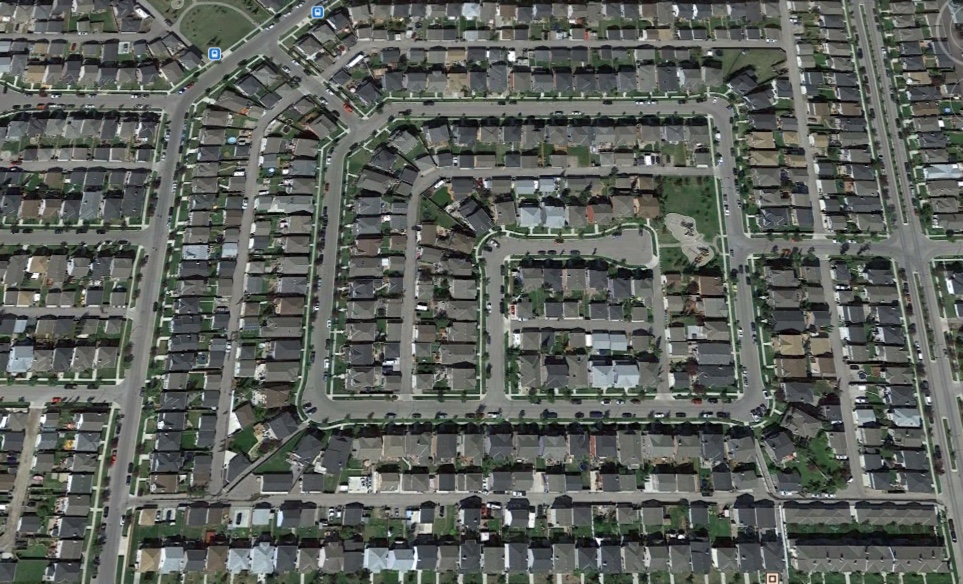
There's plenty of scope for rooftop solar in Calgary's suburbs. (Part of McKenzie Towne, Google Earth)
5) A cap on oil-sands emissions
An overall cap of 100 Mt CO2e per year has been set for the oil-sands sector. The first diagram in this post shows that current oil-sands emissions are around 72 Mt and that projected (pre-policy) emissions are 112Mt. The remaining allowance under the new policy means leaving enough room for a rise in production of, very roughly, 1 million barrels per day of bitumen at current average levels of upstream emissions. The proposed Energy East Pipeline will carry this volume, approximately. If the bitumen industry intends to grow production by more than 40%, it will have to find ways to reduce its emissions per barrel.
It is far from clear how this cap will be administered. It is a cap on emissions rather than production, which makes it even harder to determine when the line is to be crossed as new projects apply for government sanction. Canada's biggest oil lobbyist, CAPP, doesn't like it at all.
6) Fugitive methane
Alberta's oil and gas sector emits 29 Mt of CO2e as methane, annually. (That's 1.2 Mt of CH4 or 1.8 million cubic metres or 65 billion cubic feet.) Through regulation and offset credits aimed at mandating and encouraging implementation of new technology, the intent is to decrease methane emissions to 60% of 2013 levels by 2030. Methane emissions come mainly from the province's conventional oil and gas as well as the unconventional gas industries.
A recent joint report by the Environmental Defense Fund and the Pembina Institute found that Alberta could reduce its methane emissions by 16 million tonnes CO2e (45% of the total, their numbers are a little different) at an average cost of CAD$2.57 per tonne.
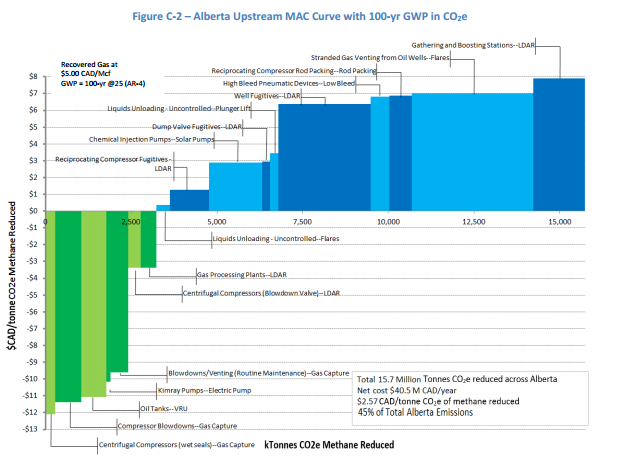
The y-axis shows the cost of mitigation (green makes money, blue costs money) and the x-axis shows how much methane, measured as kt of CO2e of annual emissions, is mitigated. If oil and gas companies paid CAD$30/tonne CO2e on their methane emissions, this histogram would all be deep in the green. The Pembina Institute, co-author of this study, had input into the new Alberta policy.
7. What's missing
Although the Climate Leadership Report is very comprehensive there are a few things that are either missing or downplayed:
- Carbon capture and storage. CCS is mentioned only three times in the report, twice in the body of the text in the past tense and once in the Glossary. Under previous governments, CCS had been touted as a key solution to mitigation. There is one active CCS project, Shell's Quest, which has just started and that will sequester 1 million tonnes of CO2 per year at a cost of CAD$72 per tonne. It is subsidized heavily by government. Even at proposed carbon tax levels of CAD$60 per tonne in 2050, hefty direct subsidies for CCS would still be needed.
- Increased electricity trade with neighbouring British Columbia. In Europe, Norway is sometimes referred to as the "battery of Europe", using its hydroelectricity to compensate for intermittency in other countries' wind and solar generation. There seems to be no reason why hydro-rich BC could not provide the same service to Alberta.
- Nuclear power.
These items were likely ruled out-of-scope by the Alberta Government and/or were not pushed significantly by stakeholders during the consultation process.
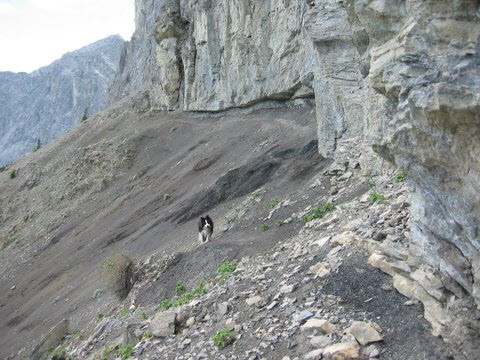
Another gratuitous Alberta Rockies picture. This is of the McConnell Thrust on Mount Yamnuska, where Lower Cambrian carbonates have been thrust over Upper Cretaceous shales and sandstones. The horizontal displacement on the fault is at least 30 km. This fault was first identified in the late nineteenth century. The evident large horizontal displacements on this and other faults in Alberta, consistent with continental drift, were ignored for many decades by most N American geologists who favoured vertically-dominated tectonics. Sheepdog for scale.
Why this policy is a big deal...
As every country in the world searches to find policies that will allow them to meet their mitigation pledges made at the COP21 meeting in Paris, Alberta has set a thoughtful example. Economists almost universally favour carbon pricing as a mitigation mechanism and many, if not most, of them prefer a carbon tax over other pricing methods. Mitigation pessimists are quick to allege that it is politically impossible to institute carbon pricing in regions where emissions are high and where the primary industry produces high levels of emissions. It's not.
Furthermore, pessimists object that small jurisdictions, dependent on trade, could not introduce carbon pricing because it would make their export products uncompetitive. Alberta has shown that these objections are false. It is possible to institute an economy-wide carbon tax that, properly structured, can be stringent without sacrificing competitiveness.
Many economists and policy experts argue that the only effective way to achieve necessary reductions in global emissions requires cooperation on a uniform global price on carbon. For example, read the paper We Will If You Will (see also Mackay et al. (2015)).
If Alberta, with its high emissions and dependence on high-emission industries, can bring in economy-wide carbon pricing, any government can. There are no excuses any more.
...and why it's not enough
Ambitious and innovative though they are, Alberta's new policies are not enough. The emissions future is flat, not rapidly declining, as it must be.
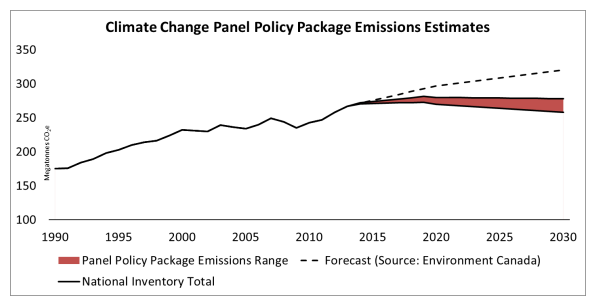 From the Climate Leadership Report.
From the Climate Leadership Report.
Canada, under the Harper government, pledged to reduce national emissions to a level 30% below its 2005 emissions by 2030.
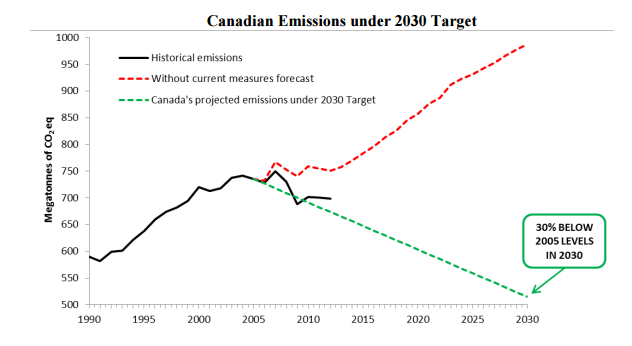 From Canada's INDC pledge. Note that the y-axis origin is not zero.
From Canada's INDC pledge. Note that the y-axis origin is not zero.
Considering that Alberta is planning, at best, to hold its emissions steady, the reduction in national emissions of 200 million tonnes per year will need to be borne by the rest of Canada in order to meet the Harper pledge. In 2030, Alberta, with just 12% of the country's population, would be producing 50% of the nation's emissions under the Harper and Notley plans.
The Harper pledge was anyway insufficient to meet the decarbonization required to meet the 2°Celsius target. This would need, roughly speaking, for emissions to fall to zero by 2050. The implication being that the Intended Nationally Determined Contribution (INDC) ought to be more like 50% below 2005's emissions by 2030, around 350 Mt.
The report Pathways to deep decarbonization in Canada lays out an ambitious plan that would see Canada's annual emissions drop from 700 Mt CO2e today to a 2-degree-consistent level of 78 Mt by 2050. Of this 78 mT, 17 would come from the upstream bitumen sector and 14 from other oil and gas production (which includes emissions from other provinces). For the extraction and upgrading of bitumen, this would entail:
Solvent extraction, direct contact steam generation (with process associated, automatic carbon dioxide sequestration) and CCS decrease the emissions intensity of oil sands production by about 90 percent relative to today’s levels. However, if production levels remain the same as in the Reference Case, this sector accounts for nearly a quarter (17 Mt) of remaining emissions in 2050.
Alberta's carbon reduction plan would fall short of providing incentives to achieve reductions of this magnitude or of allowing deployment of technologies like CCS. The Pathways report envisages a carbon price of CDN $150 by 2030 (triple the Alberta price), rising in $10 per tonne per year increments to 2050. Quite clearly, much more stringent policies would required from national and provincial governments in order for Canada to meet its fair share of emissions reductions. (Note that all production and emissions projections are sensitive to future world oil prices.)
In Paris, the new Trudeau government was among the first of the big emitters to commit to an aspirational 1.5°Celsius target. Getting there will be at least twice as hard as meeting the 2°Celsius target. The Trudeau government has not yet reset the national INDC, nor is there yet a national policy to effect any serious reduction in emissions.
Because the world has procrastinated on mitigation for so long, the best policies everywhere fall far short of the minimum targets that we need to set to avoid dangerous climate change. Canada's goals under Stephen Harper were unachievable with existing national policies. Now, Justin Trudeau has now committed the country to even more stringent reductions without yet announcing new policies to get there.
Alberta is committing to do far more than anyone just a year ago would have thought the province to be capable of. But it's still not enough. The physics and arithmetic of mitigation are brutal.
Reference
MacKay, D., Cramton, P., Ockenfels, A., & Stoft, S. (2015). Price carbon—I will if you will. Nature 526, 315–316 (15 October 2015) doi:10.1038/526315a
Here is a video of Premier Notley and others introducing the new mitigation policy
Thanks to George Morrison and Andrew Leach for comments they made on an earlier draft. No endorsement of the opinions expressed in this post is implied.































 Arguments
Arguments





















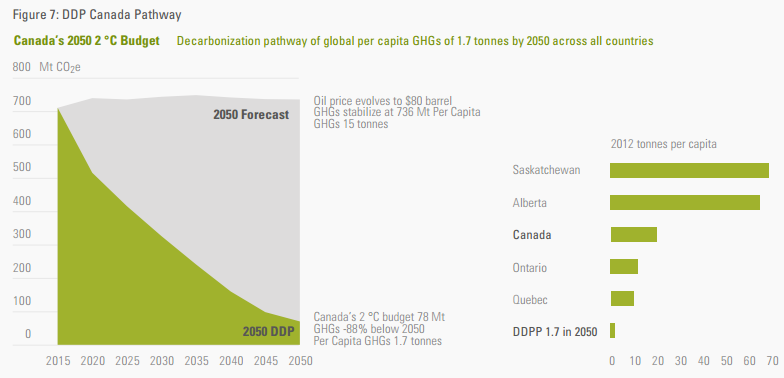









One minor clarification or correction. The claim that Alberta is the 'wealthiest' province needs clarification.
Even when oil prices were higher the GDP of Alberta was lower than Ontario, and only slightly higher than Quebec's (2014) (Stats Can Reported GDP)
Per-Capita the Alberta GDP was the highest among the provinces but the North West Territories actually had the highest per-capita GDP (Wikipedia summary of per-Capita GDP).
And the dramatic drop of oil and natural gas revenue in 2015 will likely drop Alberta in the ranks.
You underscore the high 65 tonnes per capita emissions in AB (much higher than national 15 tonnes), blaming its tar sand industries, rich McMansions.
But figure 7 shows that Saskatchewan emissions be even higher (I'm eyeballing 68 tonnes per capita). So, AB with all its tar sands does not seem to be the biggest problem in CAN.
Where do all those incredible emissions in SK come from? Why, in your analysis of CAN mitigation pledge, do you concentrate on AB, the second biggest polluter but ignore SK, the biggest one?
Or am I reading Figure 7 which show record emissions by SK, wrongly?
OPOF: Quite true, I meant per capita and didn't include the territories.
Chris: Indeed Saskatchewan has high emissions per capita, a bit higher than Alberta's. I haven't looked in detail at SK's emissions, but the province has a big heavy oil industry and relies on coal for electricity. They have a lot of catching up to do, but they have Brad Wall as premier, who is something of a mitigation skeptic. SK's population is about 1.1 million compared to AB's 4.2, so their overall emissions are much lower than Alberta's and they have not been rising as fast.
Here is the breakdown of SK's emissions, 55% from oil, gas & mining plus electricity generation.
Here is the breakdown, by province and territory, of emissions in Canada. From Environment Canada, link in the comment above.
Thanks Andy@4 for that graph which properly shows the context of your OP.
QC & ON have large populations but lower than average per capita emissions and falling recently.
Andy,
The OP alludes to what is likely required of Alberta and many other places that 'developed their economies since 1990 in ways that increased their impacts'.
Those places probably need to see a drop from their current developed perceptions of prosperity. In Alberta, that would mean reducing the rate of Oil Sands production to someting like 1 million bbls per day, a rate that does not need the Energy East Pipeline or any other new expediture that has no real future.
Getting people to accept that they do not deserve developed perceptions of prosperity has never been easy. The continued attempts to discredit the developing better understanding of climate science is proof of that.
When President Bush announced that the US was not formally signing onto the Kyoto Protocol he said Americans did not need to change the way they lived. That was a very popular statement with very damaging consequences. Similar statements have been popular in many other regions of the planet. And the government of Alberta is still trying to make them in the current attempt to buy the 'social permission' to sell oil sands as cheaply as it can get away with.
The real problem is socio-political systems based on 'regional popularity and perceptions of prosperity that come from getting away with understood to be unacceptable pursuits of profit'. Competition between such regions leads to attempts to win the most benefit in the least acceptable way that can be gotten away with. The winners of this type of 'competition' continue to effectively delay of the inevitably required and harder to accomplish global changes of attitude and action.
This policy is clearly a step in the right direction, but the willingness of the population of Alberta to support the sprint away from benefiting from fossil fuels that is required of them remains in doubt.
Re Saskatchewan - the figures for 2013 are slightly different from the 2012 figures on the Environment Canada site which you showed, but not a lot different. From the 2013 NIR, the big categories are:
- electricity 21.5% - historically mostly coal, but the current rapid expansion of capacity is mostly gas. Heavy industry accounted for about half of this in 2013, and is projected to continue to rapidly increase its demand.
- transport 19.5% - it's difficult to determin from the NIR how much of this is industry-related and how much personal, but the split on the Environment Canada piechart looks about right
- agriculture 19.2% - mostly N2O and CH4
- fugitive emissions from the oil and gas industry (venting, flaring, leaks) 17.4%. My view is that, owing to the recent massive growth of high-pressure fracking, this figure (which is basically derived from industry estimates) is a considerable underestimate. Saskatchewan only started implementing regulations on venting and flaring last year, and they are less rigorous than in neighbours such as Alberta or North Dakota (let alone Norway).
- process heat in oil/gas extraction and mining 14.7%.
Everything else is a relatively minor proportion - though the lack of a building energy code together with one of the coldest winter climates in the inhabited world means that we are using several times as much energy to heat our buildings as would be the case in say Sweden or Denmark.
The basic problem here is an economy which is heavily dependent on energy-intensive extractive industry - potash, oil, gas, minerals, coal (and much of our strongly input-dependent agriculture could be put in that category too) - and has weak manufacturing and services sectors. Combined, of course, with very weak commitments to conservation, efficiency and renewables.
Janet Keeping of the Green Party of Alberta offers a useful analysis of the Alberta plan at http://greenpartyofalberta.ca/back-to-the-drawing-board-greens-respond-to-alberta-governments-carbon-plan/
[AS] I made the link live
With the potential for rooftop solar in Alberta mentioned, it is also worth mentioning the Drake Landing Solar Community in Okotoks, Alberta, a government-sponsored project. 97% of the year-round heating comes from solar-thermal panels on the garage roofs of the 52 homes. The key to using solar heat year-round is a cluster of boreholes in a circular pattern in the ground. The ground itself is the storage medium for storing surplus heat. See: http://dlsc.ca/. See also: Bill Wong's PPT (2011).
meurig: thanks for those comments
Larry E: that Drake landing project is impressive and thank you for supplying the very interesting links.
#9 - Larry,
What a helpful, useful and encouraging post. Thank you so much! I've been trying to deal with the logistics of transitioning to renewables while living in a place where we have to deal with the life-threatening environmental problem of winter.